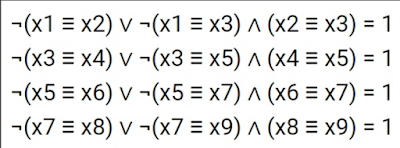Once again I strongly believe that technique proposed in http://kpolyakov.spb.ru/download/mea-2016-8.pdf seems to be underestimated either not well understood until date. Regardless Unified State Examination Polyakov's forum contains more then enough samples demonstrating advantages of 08.2016 technique. A poor understanding of the ideology 08.2016 in essence for today means a lack of understanding what kind of flexibility and power Mapping Method provides for USE in Informatics developers in meantime. See for instance (having active connection to VK)
https://vk.com/bderzhavets?w=wall209645472_433/all
Original system (((x1≡y1)≡z1) =>((x2≡y2)≡z2)) ^ (x1 v y1 v z1)=1
(((x2≡y2)≡z2) =>((x3≡y3)≡z3)) ^ (x2 v y2 v z2)=1
(((x3≡y3)≡z3) =>((x4≡y4)≡z4)) ^ (x3 v y3 v z3)=1
(((x4≡y4)≡z4) =>((x5≡y5)≡z5)) ^ (x4 v y4 v z4)=1
(((x5≡y5)≡z5) =>((x6≡y6)≡z6)) ^ (x5 v y5 v z5)=1
(((x6≡y6)≡z6) =>((x7≡y7)≡z7)) ^ (x6 v y6 v z6)=1
(x7 v y7 v z7)=1
As soon as we have a conditions that allow us to determine the bits of x(j),y(j),z(j) for the arrows outgoing from the node of the 08/2016 chart, we can start. In particular case, we are ready to go ahead with 08/2016 chart style. In other words, we have to know bits combination {x,y,z} associated with arrows connecting neighboring nodes in chart .
Cloning to {x,y,z} systems like P175 or P116 is quite straight forward
Consider second use case
((x1 v y1 v z1) =>(x2 v y2 v z2)) ^ ((x1⊕y1) =>z1) =1
((x2 v y2 v z2) =>(x3 v y3 v z3)) ^ ((x2⊕y2) =>z2) =1
((x3 v y3 v z3) =>(x4 v y4 v z4)) ^ ((x3⊕y3) =>z3) =1
((x4 v y4 v z4) =>(x5 v y5 v z5)) ^ ((x4⊕y4) =>z4) =1
((x5 v y5 v z5) =>(x6 v y6 v z6)) ^ ((x5⊕y5) =>z5) =1
((x6 v y6 v z6) =>(x7 v y7 v z7)) ^ ((x6⊕y6) =>z6) =1
((x7⊕y7)=>z7)=1
Solution via 08/2016 format
Consider third use case
(((x1≡y1)≡z1) v ((x2≡y2)≡z2)) ^ (x1 v y1 v z1)=1
(((x2≡y2)≡z2) v ((x3≡y3)≡z3)) ^ (x2 v y2 v z2)=1
(((x3≡y3)≡z3) v ((x4≡y4)≡z4)) ^ (x3 v y3 v z3)=1
(((x4≡y4)≡z4) v ((x5≡y5)≡z5)) ^ (x4 v y4 v z4)=1
(((x5≡y5)≡z5) v ((x6≡y6)≡z6)) ^ (x5 v y5 v z5)=1
(((x6≡y6)≡z6) v ((x7≡y7)≡z7)) ^ (x6 v y6 v z6)=1
(x7 v y7 v z7)=1
Solution via 08/2016 format
Passing Polyakov's control

Consider fourth use case
(((x1≡y1)≡z1) =>((x2≡y2)≡z2)) ^ ((x1 =>y1) =>z1)=1
(((x2≡y2)≡z2) =>((x3≡y3)≡z3)) ^ ((x2 =>y2) =>z2)=1
(((x3≡y3)≡z3) =>((x4≡y4)≡z4)) ^ ((x3 =>y3) =>z3)=1
(((x4≡y4)≡z4) =>((x5≡y5)≡z5)) ^ ((x4 =>y4) =>z4)≡1
(((x5≡y5)≡z5) =>((x6≡y6)≡z6)) ^ ((x5 =>y5) =>z5)=1
(((x6≡y6)≡z6) =>((x7≡y7)≡z7)) ^ ((x6 =>y6) =>z6)=1
(((x7≡y7)≡z7) =>((x8≡y8)≡z8)) ^ ((x7 =>y7) =>z7)=1
((x8 =>y8) =>z8)=1
Solution via 08/2016 format







No comments:
Post a Comment